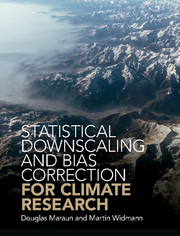Book contents
- Frontmatter
- Dedication
- Contents
- Preface
- Acknowledgements
- 1 Introduction
- Part I Background and Fundamentals
- 2 Regional Climate
- 3 History of Downscaling
- 4 Rationale of Downscaling
- 5 User Needs
- 6 Mathematical and Statistical Methods
- 7 Reference Observations
- 8 Climate Modelling
- 9 Uncertainties
- Part II Statistical Downscaling Concepts and Methods
- Part III Downscaling in Practice and Outlook
- Appendix A Methods Used in This Book
- Appendix B Useful Resources
- References
- Index
6 - Mathematical and Statistical Methods
from Part I - Background and Fundamentals
Published online by Cambridge University Press: 27 December 2017
- Frontmatter
- Dedication
- Contents
- Preface
- Acknowledgements
- 1 Introduction
- Part I Background and Fundamentals
- 2 Regional Climate
- 3 History of Downscaling
- 4 Rationale of Downscaling
- 5 User Needs
- 6 Mathematical and Statistical Methods
- 7 Reference Observations
- 8 Climate Modelling
- 9 Uncertainties
- Part II Statistical Downscaling Concepts and Methods
- Part III Downscaling in Practice and Outlook
- Appendix A Methods Used in This Book
- Appendix B Useful Resources
- References
- Index
Summary
Statistical downscaling relies on a wide range of statistical concepts. This chapter presents a concise overview of these concepts. We attempt to explain the different issues as simply as possible but with the necessary detail and background to successfully implement a broad range of statistical downscaling methods. Section 6.1 gives an overview of random variables and probability, including the most relevant probability distributions, and some very basic introduction to the modelling of extreme values. Parameter estimation, that is, basis for calibrating statistical models, is introduced in Section 6.2. Here we focus on the widely used concept of maximum likelihood but give a brief overview of Bayesian estimators as well. Regression models, the backbone of many statistical downscaling models, are presented in Section 6.3, including a discussion of statistical model selection and evaluation. Weather generators are specific stochastic processes – these are laid out briefly in Section 6.4. Finally, predictors are often post-processed based on principal component analysis, and some statistical downscaling methods employ canonical correlation analysis. These pattern methods are introduced in Section 6.5. In the following, we will write scalars in normal font, while vectors and matrices will be written in bold font. We assume that readers have basic knowledge in significance testing – it will not be introduced in this chapter but only occurs in the context of model selection. In fact, significance testing is very useful in many contexts, but it is not essential to implement a statistical downscaling method. Also, even though relevant for some predictor transformations, we do not discuss clustering algorithms.
Random Variables and Probability Distributions
Events and Random Variables
In synoptic meteorology, the atmospheric circulation is often characterised by discrete weather types. At each day, the actual circulation might randomly assume one of these types. In statistics, the space of all possible weather types is called sample space or event space S. For the considered weather types, the sample space could be, for example, S = (W,NW,N,NE, E, SE, S,SW). Subsets of the event space, for example, SE, or (NW, N, NE) (i.e. all Northerly weather types) are called events.
- Type
- Chapter
- Information
- Publisher: Cambridge University PressPrint publication year: 2018



